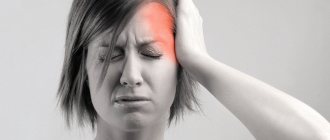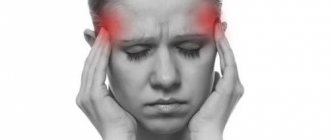Unpleasant sensations and pain in the head and eyes are familiar to everyone. This condition often only indicates overfatigue of the visual analyzer, especially during prolonged work at the computer. Therefore, when the eyes hurt when the pupils move, and a person feels dry, as if sand had gotten into them, at the first stage it is necessary to give the eyes a rest (especially if you feel pain in the eyes when working at the computer or reading). However, if this does not help, then it is necessary to exclude pathological processes that manifest themselves with similar symptoms from the visual analyzer. It can be:
- 1. Increased intraocular pressure. In this case, a person most often feels that the eye hurts inside. This condition can be transient and accompany, for example, migraine or brain pathology, or it can be permanent and lead to gradual retinal detachment associated with glaucoma. In this case, the eyeball becomes rocky when palpated.
- 2. Infectious diseases of the eyes, brain and intoxication. Inflammation of the mucous membrane of the eye - conjunctivitis - is a common cause of pain when blinking and at rest. Pain in the orbit that occurs when moving the eyes indicates that the eye muscles and nerves are involved in the inflammatory process. This situation can occur both during intoxication due to common flu or acute respiratory infections, and during such serious diseases as meningitis, encephalitis, etc. Inflammation of the paranasal sinuses (sinusitis or sinusitis) can cause pain in the nose and eyes. With the development of complicated forms of these diseases, pus can penetrate into the orbital cavity.
- 3. Trauma to the eyeball, head and facial skull can lead to pain in the orbits and eyes. The reason is direct mechanical impact or the entry of foreign objects into the visual analyzer. A concussion may also cause pain in the forehead or temple when moving the eyes.
- 4. Diseases of the eye appendages. A number of diseases can lead not to an eye problem, but to inflammation of the lacrimal glands (dacryocystitis) or eyelids (maybeitis).
What to do if you have a headache when you move your eyes?
Headache when moving the eyes and at rest (whether it is pain in the eyes when reading or working on a computer) is an extremely unpleasant condition for a person. Therefore, it is urgent to take a painkiller from the group of non-steroidal anti-inflammatory drugs. The next step in helping a person is to see a doctor. If there are signs of a general infectious disease (flu, acute respiratory infections), then a general practitioner will be able to provide adequate medical care. In other cases, consultation with an ophthalmologist and often a neurologist is necessary. If the cause of pain in the eye is a foreign object or injury, in no case should you rub your eyes or try to reach such an object directly with your fingers. It is necessary to rinse your eyes generously with clean water. If this does not produce results, seek medical help immediately.
Common causes of headaches behind the eyeballs
Migraine
Migraine headache is the most common type of disabling headache. This is an intermittent headache that lasts up to 72 hours and often causes severe throbbing pain on one side of the head and behind the eye. Migraine headaches can also spread to the back of the head.
Other typical migraine symptoms include nausea, vomiting, and sensitivity to light, smells, and sounds.
“The term 'migraine' comes from the word megrim, which means 'headache accompanied by nausea.' During a migraine attack, people feel nauseous,” Fr.
Visual disturbances, such as flashing lights or halos around lights, called a migraine aura, may precede a headache, but most migraine sufferers do not experience a migraine aura.
There are many factors that trigger a migraine attack. These include fatigue, emotional stress, too little or too much sleep, skipping meals, bright or flickering lights, strong odors, loud noises, certain foods, and changes in temperature and humidity.
The development of migraine also appears to be influenced by genetic factors, as 70% of migraine sufferers report at least one close relative with a history of migraine.
Migraine diagnosed early can be successfully treated without prescription painkillers, but some available prescription medications can be used to both prevent and reduce attacks and relieve acute migraine headaches.
Chronic migraines may need to be taken daily to treat chronic migraines and prevent headaches behind the eyes.
Cluster headaches
Cluster headaches are characterized by multiple, frequent, short, and extremely painful headache attacks. These periods of cluster pain can last for weeks or months, followed by a period of remission where the headache does not occur for months or years.
This type of headache usually appears quite quickly, sometimes with an aura, and can last up to three hours. Symptoms include excruciating pain (often a headache behind one eyeball) that can spread to other parts of the face, head and neck, redness and swelling of the eyes, and excessive watery eyes.
It is believed that the cause of cluster headaches may be disorders in the hypothalamus (a part of the brain that controls many vital functions of the body). To date, there are no established mechanisms of occurrence and methods for permanent elimination of cluster pain behind the eyeballs.
Treatment for this type of pain focuses on reducing the severity of the pain, shortening the duration of pain, and preventing future attacks. Some of the most popular treatments are oxygen therapy, triptan injections and local anesthetics.
Sinus infections
The sinuses are air-filled cavities in the facial bones. They are located deep in the nose, inside the forehead and cheeks, and behind the eyeballs. A sinus infection (sinusitis) is a common cause of pain, including headaches behind the eyes.
Migraine headaches are often misdiagnosed as headaches caused by sinusitis. Treatment for headaches caused by sinusitis involves treating the underlying infection with prescription antibiotics and decongestants.
Treatment for eye movement disorders
There are many reasons why the eyes hurt and there is a violation of their movement. However, this combination of symptoms indicates a severe pathology, where self-medication is inappropriate. Disorders of eye movements occur most often due to neurological pathology (diseases of the cranial nerves or circulatory disorders in the brain). An infectious process in the orbit can lead to a temporary disturbance in movement and a condition where the eye muscles hurt when moving upward (most often, such symptoms are observed with inflammation in the lower fornix of the orbit). Treatment of eye movement disorders can only be carried out by an ophthalmologist in joint consultation with related specialists (neurologists, neurosurgeons). If pain in the eye when moving the eyeball haunts you, contact the Neuro-Med clinic for help. Our specialists will advise you in detail on all issues, as well as prescribe suitable treatment.
Complications
Most often, headaches can be controlled with the help of painkillers. But most patients again experience pain after a while, which negatively affects everyday life. In this case, only a specialist can help, who will help adjust the treatment therapy and eliminate the pain.
As a rule, there are no complications with headaches. They can become permanent, develop into a migraine, or spread to other parts of the body. To improve the prognosis, it is necessary to correctly determine the root cause and choose treatment.
Treatment of frontal sinusitis
After diagnosis, the doctor prescribes appropriate treatment. The treatment regimen depends on the severity of the disease and the cause that caused it. Treatment can take place at home. Only those with severe bilateral frontal sinusitis are sent to the hospital.
The main goal of treatment is to provide drainage, i.e. outflow of inflammatory contents from the frontal sinuses. Additionally, measures are taken to restore normal breathing and prevent complications. At the first stage of treatment, medications are used:
- antibiotics: Amoxiclav, Sumamed, Doxycycline, Ceftriaxone. A specific drug is prescribed taking into account the causative agent of frontal sinusitis;
- local antibiotics: Bioparox, Polydexa. They are produced in the form of a spray, and are used to act on bacteria directly at the place of their reproduction - in the nasal cavity;
- local antiseptics, for example, Miramistin. It can be used to rinse the nose. The drug will help wash away bacteria from the mucous membrane and remove the contents of the nasal cavity out;
- antihistamines: Diphenhydramine, Suprastin, Tavegil. Prescribed for allergic nature of the disease;
- for nasal rinsing: Aqua Maris, Afrin, Quicks. They cleanse the nasal cavity of purulent contents, moisturize the mucous membrane and facilitate breathing;
- vasoconstrictor drops: Galazolin, Naphthyzin, Nazol. They are necessary to restore normal nasal breathing;
- antipyretics: Panadol, Paracetamol, Nurofen. Used when the temperature rises above 38.5°C;
- homeopathic remedies: Sinupret, Cetirizine, Tavegil. They help relieve swelling and inflammation, ensure the opening of the sinuses and normal breathing.
Physiotherapy methods are used in combination with drug treatment. Several procedures show good results for frontal sinusitis:
- laser therapy;
- UHF therapy;
- quartzization of the nasal cavity;
- irradiation with a Sollux lamp.
Surgery
If the disease cannot be controlled with the help of medications, then doctors perform surgery. There are several types of operations performed.
1. Puncture of the frontal sinuses. The procedure is also called a puncture. It takes place in several stages:
- the patient is given local anesthesia, after which a special needle is inserted into the nose;
- along its end, which remains outside, purulent contents flow out of the nose;
- when all the liquid comes out, the specialist applies an antiseptic inside to rinse the cavities;
- if there is a lot of discharge or it is purulent, then the doctor can insert a catheter through the needle, which will remain there for a while. Through the device, secretions can come out, and washing is also carried out through it.
2. Sinoplasty. An endoscope is inserted into the nasal cavity, and a special balloon is inserted through it. The latter is inflated to widen the anastomosis. Through the wide opening, secretions can easily flow out.
3. Open. Radical interventions are rarely performed, since they severely injure the tissue. Open surgery is performed through an incision above the bridge of the nose, a hole in the bone at the bottom of the frontal sinus, and sometimes through the nose.
The operation is also performed when frontal sinusitis was caused by a deviated nasal septum, adenoids or polyps. Intervention helps to get rid of these defects.
Indications for frontal sinusitis
To speed up recovery, with frontal sinusitis the patient should adhere to some recommendations:
- regularly ventilate the room in which the patient is located;
- humidify the air daily;
- observe bed or semi-bed rest;
- provide plenty of warm drinks and easily digestible food.
During frontal sinusitis, it is very important to regularly rinse your nose so that you can breathe normally and the nasal cavity is not filled with inflammatory contents. A regular syringe without a needle is suitable for rinsing. A solution is drawn into it, which is then poured into one nostril.
It is better to carry out the procedure over a sink. The head must be turned to the side. The solution is poured into the nostril, which, when tilted, turns out to be the top. The fluid should come out of the other nostril. A sea salt solution is considered a classic solution for washing. For a glass of boiled water, 1/3 teaspoon of salt is enough.
It is important that its crystals completely dissolve, otherwise the mucous membrane can be injured. You can rinse your nose up to 5-6 times a day. If the nose is stuffy, then before the procedure it is necessary to instill vasoconstrictor drops, otherwise the solution will not be able to pass through the nasal passages.
Prevention
Most diseases cause pain, which is almost impossible to prevent. In this regard, there are no precise preventive measures. To prevent the development of unpleasant sensations, you should protect the body from overexertion. Mental and physical fatigue can negatively affect people's health.
To prevent severe headaches, you should spend more time outdoors. Also, regular exposure to the street will contribute to the overall strengthening of the body.
Attention should be paid to a healthy lifestyle, especially for people who have sedentary jobs. Adequate sleep is also important, the duration of which should be at least 8 hours a day. This time is enough for the body to regain strength and rest. To ease pain, you can, if possible, replace trips on public transport with walking.
It must be remembered that the more the patient protects himself from stress and various strains, the less pain will appear in the right side of the head and eyes.
Causes of frontal sinusitis
Frontal sinusitis rarely develops as an independent pathology. In most cases, it develops against the background of other diseases, most often of the ENT organs. This group of causes of frontal sinusitis includes the following pathologies:
- tonsillitis;
- sinusitis;
- pharyngitis;
- adenoids;
- chronic, allergic or vasomotor rhinitis;
- tubootitis.
With such diseases, there is a potential source of infection in the body, which can spread to the frontal sinuses. The causes of frontal sinusitis also include immunodeficiency states due to AIDS, malignant tumors, and if the patient receives radiation therapy.
Inflammation of the frontal sinuses is caused by various traumatic injuries or operations in the skull area, if they lead to deformation or blockage of the excretory duct or narrowing of the frontal sinus. Traumatic causes also include:
- deviated nasal septum;
- deformation of the ethmoid labyrinth and middle turbinate;
- other anomalies of the structure of the nose;
- fractures or displacement of the nasal septum.
Even improper nose blowing, when a person blows both nostrils at the same time, can act as a trigger for the onset of inflammation. Depending on the cause, frontal sinusitis is divided into several types:
- allergic;
- bacterial (the disease is caused by staphylococci, hemophilus influenzae, streptococci and other bacteria);
- viral (inflammation of the frontal sinuses occurs against the background of acute respiratory viral infections, influenza, measles, rubella, damage by adenoviruses, etc.);
- fungal;
- mixed.
In children, frontal sinusitis may occur no earlier than 5 years of age. Until this age, the child’s frontal sinuses are not yet fully developed. They cannot become inflamed, and therefore frontal sinusitis does not develop. In childhood, the disease most often occurs due to an allergic runny nose or foreign bodies entering the nasal cavity. Also, frontal sinusitis in children can be caused by the same factors as in adults.









